FDA无菌加工生产的无菌药品指南中英文对照版
EUGMP-中英文对照[1]
![EUGMP-中英文对照[1]](https://img.taocdn.com/s3/m/ed974fef59eef8c75ebfb3e2.png)
EU GMP ANNEX 1 MANUFACTURE OF STERILE MEDICINAL PRODUCTS (中英文对照)(a) These are average values. (一)这些都是平均值。
(b) Individual settle plates may be exposed for less than 4 hours. (二)单个沉降皿放置的时间可以少于4小时。
20. Appropriate alert and action limits should be set for the results of particulate and microbiological monitoring. If these limits are exceeded operating procedures should prescribe corrective action。
对尘埃粒子和微生物的监控结果,要设置适当的警戒限度和行动限度。
当超出这些限度时,操作规程应说明需要采取的措施。
Isolator technology 隔离技术21. The utilisation of isolator technology to minimize human interventions in processing areas may result in a significant decrease in the risk of microbiological contamination of aseptically manufactured products from the environment. There are many possible designs of isolators and transfer devices. The isolator and the background environment should be designed so that the required air quality for the respective zones can be realised. Isolators are constructed of various materials more or less prone to puncture and leakage. Transfer devices may vary from a single door to double door designs to fully sealed systems incorporating sterilization mechanisms. 在生产区采用人员方面的隔离技术,在无菌产品的生产中,会显著降低周围环境微生物污染的风险。
中英文对照FDA原料药GMP指南
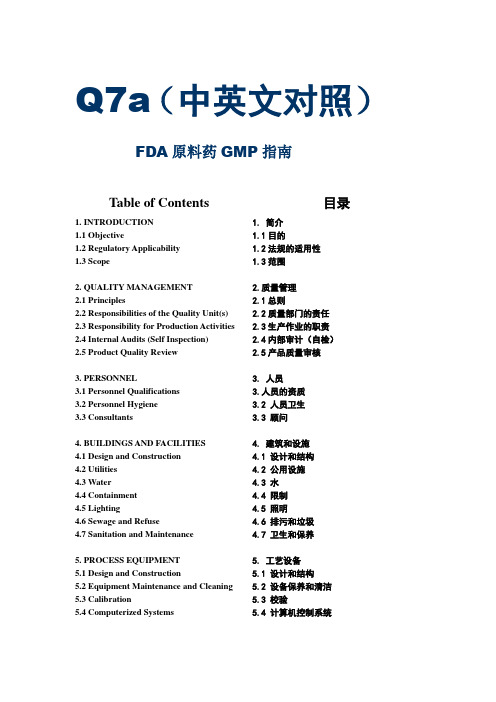
Q7a(中英文对照)FDA原料药GMP指南Table of Contents 目录1. INTRODUCTION 1. 简介1.1 Objective 1.1目的1.2 Regulatory Applicability 1.2法规的适用性1.3 Scope 1.3范围2. QUALITY MANAGEMENT 2.质量管理2.1 Principles 2.1总则2.2 Responsibilities of the Quality Unit(s) 2.2质量部门的责任2.3 Responsibility for Production Activities 2.3生产作业的职责2.4 Internal Audits (Self Inspection) 2.4内部审计(自检)2.5 Product Quality Review 2.5产品质量审核3. PERSONNEL 3. 人员3.1 Personnel Qualifications 3.人员的资质3.2 Personnel Hygiene 3.2 人员卫生3.3 Consultants 3.3 顾问4. BUILDINGS AND FACILITIES 4. 建筑和设施4.1 Design and Construction 4.1 设计和结构4.2 Utilities 4.2 公用设施4.3 Water 4.3 水4.4 Containment 4.4 限制4.5 Lighting 4.5 照明4.6 Sewage and Refuse 4.6 排污和垃圾4.7 Sanitation and Maintenance 4.7 卫生和保养5. PROCESS EQUIPMENT 5. 工艺设备5.1 Design and Construction 5.1 设计和结构5.2 Equipment Maintenance and Cleaning 5.2 设备保养和清洁5.3 Calibration 5.3 校验5.4 Computerized Systems 5.4 计算机控制系统6. DOCUMENTATION AND RECORDS 6. 文件和记录6.1 Documentation System andSpecifications6.1 文件系统和质量标准6.2 Equipment cleaning and Use Record 6.2 设备的清洁和使用记录6.3 Records of Raw Materials, Intermediates, API Labeling and Packaging Materials 6.3 原料、中间体、原料药的标签和包装材料的记录6.4 Master Production Instructions (MasterProduction and Control Records)6.4 生产工艺规程(主生产和控制记录)6.5 Batch Production Records (BatchProduction and Control Records)6.5 批生产记录(批生产和控制记录)6.6 Laboratory Control Records 6.6 实验室控制记录6.7 Batch Production Record Review 6.7批生产记录审核7. MATERIALS MANAGEMENT 7. 物料管理7.1 General Controls 7.1 控制通则7.2 Receipt and Quarantine 7.2接收和待验7.3 Sampling and Testing of IncomingProduction Materials7.3 进厂物料的取样与测试7.4 Storage 7.4储存7.5 Re-evaluation 7.5复验8. PRODUCTION AND IN-PROCESSCONTROLS8. 生产和过程控制8.1 Production Operations 8.1 生产操作8.2 Time Limits 8.2 时限8.3 In-process Sampling and Controls 8.3 工序取样和控制8.4 Blending Batches of Intermediates orAPIs8.4 中间体或原料药的混批8.5 Contamination Control 8.5 污染控制9. PACKAGING AND IDENTIFICATIONLABELING OF APIs ANDINTERMEDIATES9. 原料药和中间体的包装和贴签9.1 General 9.1 总则9.2 Packaging Materials 9.2 包装材料9.3 Label Issuance and Control 9.3 标签发放与控制9.4 Packaging and Labeling Operations 9.4 包装和贴签操作10. STORAGE AND DISTRIBUTION 10.储存和分发10.1 Warehousing Procedures 10.1 入库程序10.2 Distribution Procedures 10.2 分发程序11. LABORATORY CONTROLS 11.实验室控制11.1 General Controls 11.1 控制通则11.2 Testing of Intermediates and APIs 11.2 中间体和原料药的测试11.3 Validation of Analytical Procedures 11.3 分析方法的验证11.4 Certificates of Analysis 11.4 分析报告单11.5 Stability Monitoring of APIs 11.5 原料药的稳定性监测11.6 Expiry and Retest Dating 11.6 有效期和复验期11.7 Reserve/Retention Samples 11.7 留样12. V ALIDATION 12.验证12.1 Validation Policy 12.1 验证方针12.2 Validation Documentation 12.2 验证文件12.3 Qualification 12.3 确认12.4 Approaches to Process Validation 12.4 工艺验证的方法12.5 Process Validation Program 12.5 工艺验证的程序12.6 Periodic Review of Validated Systems 12.6验证系统的定期审核12.7 Cleaning Validation 12.7 清洗验证12.8 Validation of Analytical Methods 12.8 分析方法的验证13. CHANGE CONTROL 13.变更的控制14. REJECTION AND RE-USE OFMATERIALS14.拒收和物料的再利用14.1 Rejection 14.1 拒收14.2 Reprocessing 14.2 返工14.3 Reworking 14.3 重新加工14.4 Recovery of Materials and Solvents 14.4 物料与溶剂的回收14.5 Returns 14.5 退货15. COMPLAINTS AND RECALLS 15.投诉与召回16. CONTRACT MANUFACTURERS(INCLUDING LABORATORIES)16.协议生产商(包括实验室)17. AGENTS, BROKERS, TRADERS, DISTRIBUTORS, REPACKERS, AND RELABELLERS 17.代理商、经纪人、贸易商、经销商、重新包装者和重新贴签者17.1 Applicability 17.1适用性17.2 Traceability of Distributed APIs andIntermediates17.2已分发的原料药和中间体的可追溯性17.3 Quality Management 17.3质量管理17.4 Repackaging, Relabeling, and Holding of APIs and Intermediates 17.4原料药和中间体的重新包装、重新贴签和待检17.5 Stability 17.5稳定性17.6 Transfer of Information 17.6 信息的传达17.7 Handling of Complaints and Recalls 17.7 投诉和召回的处理17.8 Handling of Returns 17.8 退货的处理18. Specific Guidance for APIs Manufactured by Cell Culture/Fermentation 18. 用细胞繁殖/发酵生产的原料药的特殊指南18.1 General 18.1 总则18.2 Cell Bank Maintenance and RecordKeeping18.2细胞库的维护和记录的保存18.3 Cell Culture/Fermentation 18.3细胞繁殖/发酵18.4 Harvesting, Isolation and Purification 18.4收取、分离和精制18.5 Viral Removal/Inactivation steps 18.5 病毒的去除/灭活步骤19.APIs for Use in Clinical Trials 19.用于临床研究的原料药19.1 General 19.1 总则19.2 Quality 19.2 质量19.3 Equipment and Facilities 19.3 设备和设施19.4 Control of Raw Materials 19.4 原料的控制19.5 Production 19.5 生产19.6 Validation 19.6 验证19.7 Changes 19.7 变更19.8 Laboratory Controls 19.8 实验室控制19.9 Documentation 19.9 文件20. Glossary 20. 术语Q7a GMP Guidance for APIs Q7a原料药的GMP指南1. INTRODUCTION 1. 简介1.1 Objective 1.1目的This document is intended to provide guidance regarding good manufacturing practice (GMP) for the manufacturing of active pharmaceutical ingredients (APIs) under an appropriate system for managing quality. It is also intended to help ensure that APIs meet the quality and purity characteristics that they purport, or are represented, to possess. 本文件旨在为在合适的质量管理体系下制造活性药用成分(以下称原料药)提供有关优良药品生产管理规范(GMP)提供指南。
FDA-GMP中英文对照标准版
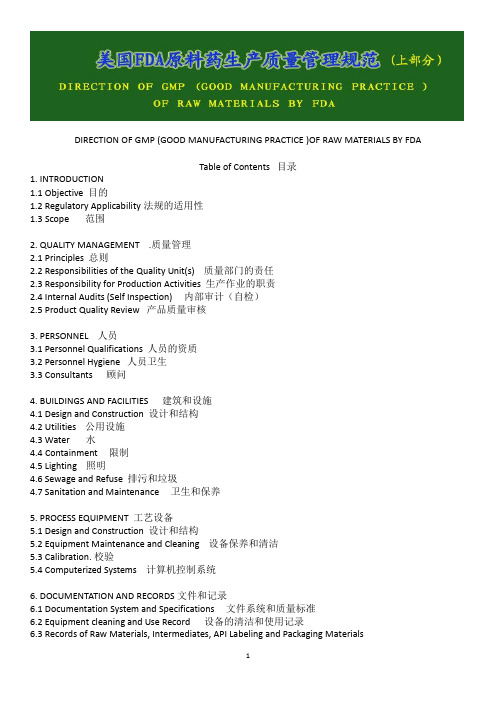
DIRECTION OF GMP (GOOD MANUFACTURING PRACTICE )OF RAW MATERIALS BY FDATable of Contents 目录1. INTRODUCTION1.1 Objective 目的1.2 Regulatory Applicability法规的适用性1.3 Scope 范围2. QUALITY MANAGEMENT .质量管理2.1 Principles 总则2.2 Responsibilities of the Quality Unit(s) 质量部门的责任2.3 Responsibility for Production Activities 生产作业的职责2.4 Internal Audits (Self Inspection) 内部审计(自检)2.5 Product Quality Review 产品质量审核3. PERSONNEL 人员3.1 Personnel Qualifications 人员的资质3.2 Personnel Hygiene 人员卫生3.3 Consultants 顾问4. BUILDINGS AND FACILITIES 建筑和设施4.1 Design and Construction 设计和结构4.2 Utilities 公用设施4.3 Water 水4.4 Containment 限制4.5 Lighting 照明4.6 Sewage and Refuse 排污和垃圾4.7 Sanitation and Maintenance 卫生和保养5. PROCESS EQUIPMENT 工艺设备5.1 Design and Construction 设计和结构5.2 Equipment Maintenance and Cleaning 设备保养和清洁5.3 Calibration. 校验5.4 Computerized Systems 计算机控制系统6. DOCUMENTATION AND RECORDS 文件和记录6.1 Documentation System and Specifications 文件系统和质量标准6.2 Equipment cleaning and Use Record 设备的清洁和使用记录6.3 Records of Raw Materials, Intermediates, API Labeling and Packaging Materials原料、中间体、原料药的标签和包装材料的记录6.4 Master Production Instructions (Master Production and Control Records)生产工艺规程(主生产和控制记录)6.5 Batch Production Records (Batch Production and Control Records)批生产记录(批生产和控制记录)6.6 Laboratory Control Records 实验室控制记录6.7 Batch Production Record Review 批生产记录审核7. MATERIALS MANAGEMENT 物料管理7.1 General Controls 控制通则7.2 Receipt and Quarantine 接收和待验7.3 Sampling and Testing of Incoming Production Materials 进厂物料的取样与测试7.4 Storage 储存7.5 Re-evaluation 复验8. PRODUCTION AND IN-PROCESS CONTROLS 生产和过程控制8.1 Production Operations 生产操作8.2 Time Limits 时限8.3 In-process Sampling and Controls 工序取样和控制8.4 Blending Batches of Intermediates or APIs 中间体或原料药的混批8.5 Contamination Control 污染控制9. PACKAGING AND IDENTIFICATION LABELING OF APIs AND INTERMEDIATES原料药和中间体的包装和贴签9.1 General 总则9.2 Packaging Materials 包装材料9.3 Label Issuance and Control 标签发放与控制9.4 Packaging and Labeling Operations 包装和贴签操作10. STORAGE AND DISTRIBUTION.储存和分发10.1 Warehousing Procedures 入库程序10.2 Distribution Procedures 分发程序11. LABORATORY CONTROLS 实验室控制11.1 General Controls 控制通则11.2 Testing of Intermediates and APIs 中间体和原料药的测试11.3 Validation of Analytical Procedures 分析方法的验证11.4 Certificates of Analysis分析报告单11.5 Stability Monitoring of APIs 原料药的稳定性监测11.6 Expiry and Retest Dating 有效期和复验期11.7 Reserve/Retention Samples 留样12. VALIDATION .验证12.1 Validation Policy 验证方针12.2 Validation Documentation 验证文件12.3 Qualification 确认12.4 Approaches to Process Validation 工艺验证的方法12.5 Process Validation Program 工艺验证的程序12.6 Periodic Review of Validated Systems 验证系统的定期审核12.7 Cleaning Validation 清洗验证12.8 Validation of Analytical Methods 分析方法的验证13. CHANGE CONTROL 变更的控制14. REJECTION AND RE-USE OF MATERIALS.拒收和物料的再利用14.1 Rejection 拒收14.2 Reprocessing 返工14.3 Reworking 重新加工14.4 Recovery of Materials and Solvents 物料与溶剂的回收14.5 Returns 退货15. COMPLAINTS AND RECALLS 投诉与召回16. CONTRACT MANUFACTURERS (INCLUDING LABORATORIES)协议生产商(包括实验室)17. AGENTS, BROKERS, TRADERS, DISTRIBUTORS, REPACKERS, AND RELABELLERS 代理商、经纪人、贸易商、经销商、重新包装者和重新贴签者17.1 Applicability 适用性17.2 Traceability of Distributed APIs and Intermediates已分发的原料药和中间体的可追溯性17.3 Quality Management 质量管理17.4 Repackaging, Relabeling, and Holding of APIs and Intermediates原料药和中间体的重新包装、重新贴签和待检17.5 Stability 稳定性17.6 Transfer of Information 信息的传达17.7 Handling of Complaints and Recalls 投诉和召回的处理17.8 Handling of Returns 退货的处理18. Specific Guidance for APIs Manufactured by Cell Culture/Fermentation用细胞繁殖/发酵生产的原料药的特殊指南18.1 General 总则18.2 Cell Bank Maintenance and Record Keeping 细胞库的维护和记录的保存18.3 Cell Culture/Fermentation 细胞繁殖/发酵18.4 Harvesting, Isolation and Purification 收取、分离和精制18.5 Viral Removal/Inactivation steps 病毒的去除/灭活步骤19. APIs for Use in Clinical Trials 用于临床研究的原料药19.1 General 总则19.2 Quality 质量19.3 Equipment and Facilities设备和设施19.4 Control of Raw Materials 原料的控制19.5 Production 生产19.6 Validation 验证19.7 Changes 变更19.8 Laboratory Controls 实验室控制19.9 Documentation 文件20. Glossary 术语1. INTRODUCTION 1. 简介1.1 Objective 1.1目的This document is intended to provide guidance regarding good manufacturing practice (GMP) for the manufacturing of active pharmaceutical ingredients (APIs) under an appropriate system for managing quality. It is also intended to help ensure that APIs meet the quality and purity characteristics that they purport, or are represented, to possess.本文件旨在为在合适的质量管理体系下制造活性药用成分(以下称原料药)提供有关优良药品生产管理规范(GMP)提供指南。
美国FDA原料药生产质量管理规范( 中英文)
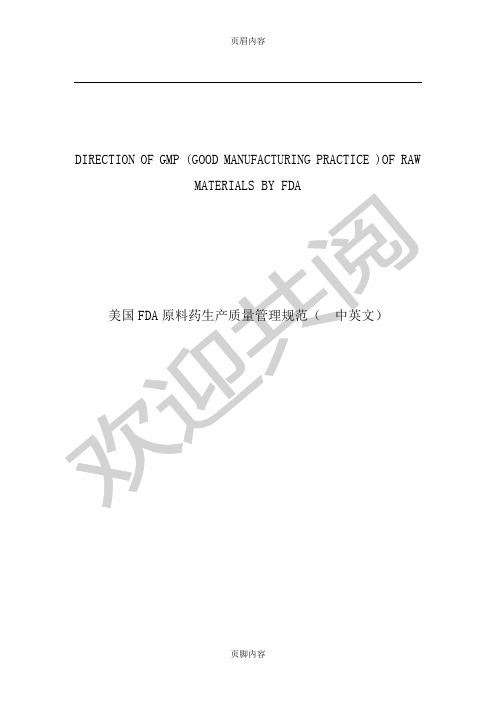
DIRECTION OF GMP (GOOD MANUFACTURING PRACTICE )OF RAWTable of Contents 目录1. INTRODUCTION 简介1.1 Objective 目的1.2 Regulatory Applicability法规的适用性1.3 Scope 范围4. BUILDINGS AND FACILITIES 建筑和设施4.1 Design and Construction 设计和结构4.2 Utilities 公用设施4.3 Water 水4.4 Containment 限制4.5 Lighting 照明4.6 Sewage and Refuse 排污和垃圾4.7 Sanitation and Maintenance 卫生和保养生产工艺规程(主生产和控制记录)6.5 Batch Production Records (Batch Production and Control Records)批生产记录(批生产和控制记录)6.6 Laboratory Control Records 实验室控制记录6.7 Batch Production Record Review 批生产记录审核7. MATERIALS MANAGEMENT 物料管理7.1 General Controls 控制通则7.2 Receipt and Quarantine 接收和待验7.3 Sampling and Testing of Incoming Production Materials 进厂物料的取样与测试9.1 General 总则9.2 Packaging Materials 包装材料9.3 Label Issuance and Control 标签发放与控制9.4 Packaging and Labeling Operations 包装和贴签操作10. STORAGE AND DISTRIBUTION.储存和分发10.1 Warehousing Procedures 入库程序10.2 Distribution Procedures 分发程序11. LABORATORY CONTROLS 实验室控制12.4 Approaches to Process Validation 工艺验证的方法12.5 Process Validation Program 工艺验证的程序12.6 Periodic Review of Validated Systems 验证系统的定期审核12.7 Cleaning Validation 清洗验证12.8 Validation of Analytical Methods 分析方法的验证13. CHANGE CONTROL 变更的控制14. REJECTION AND RE-USE OF MATERIALS.拒收和物料的再利用14.1 Rejection 拒收17.2 Traceability of Distributed APIs and Intermediates已分发的原料药和中间体的可追溯性17.3 Quality Management 质量管理17.4 Repackaging, Relabeling, and Holding of APIs and Intermediates原料药和中间体的重新包装、重新贴签和待检17.5 Stability 稳定性17.6 Transfer of Information 信息的传达17.7 Handling of Complaints and Recalls 投诉和召回的处理17.8 Handling of Returns 退货的处理19.4 Control of Raw Materials 原料的控制19.5 Production 生产19.6 Validation 验证19.7 Changes 变更19.8 Laboratory Controls 实验室控制19.9 Documentation 文件20. Glossary 术语1. INTRODUCTION 1. 简介1.1 Objective 1.1目的This document is intended to provide guidance regarding good manufacturing practice (GMP) for the manufacturing of active pharmaceutical ingredients (APIs) under an appropriate system for managing quality. It is also intended to help ensure that APIs meet the quality and purity characteristics that they purport, or arerepresented, to possess.are inherent responsibilities of the manufacturer and are governed by nationallaws.本指南在总体上未涉及生产人员的安全问题,亦不包括环保方面的内容。
FDAGMP中英文对照标准
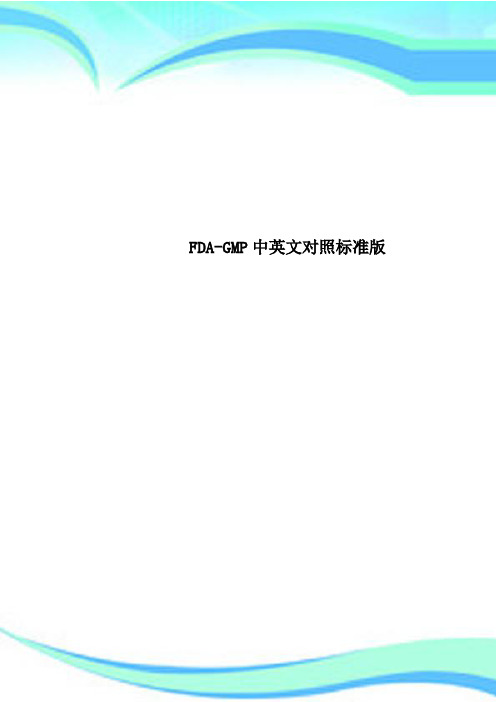
FDA-GMP中英文对照标准版————————————————————————————————作者:————————————————————————————————日期:DIRECTION OF GMP (GOOD MANUFACTURING PRACTICE )OF RAW MATERIALS BY FDATable of Contents 目录1. INTRODUCTION1.1 Objective 目的1.2 Regulatory Applicability法规的适用性1.3 Scope 范围2. QUALITY MANAGEMENT .质量管理2.1 Principles 总则2.2 Responsibilities of the Quality Unit(s) 质量部门的责任2.3 Responsibility for Production Activities 生产作业的职责2.4 Internal Audits (Self Inspection) 内部审计(自检)2.5 Product Quality Review 产品质量审核3. PERSONNEL 人员3.1 Personnel Qualifications 人员的资质3.2 Personnel Hygiene 人员卫生3.3 Consultants 顾问4. BUILDINGS AND FACILITIES 建筑和设施4.1 Design and Construction 设计和结构4.2 Utilities 公用设施4.3 Water 水4.4 Containment 限制4.5 Lighting 照明4.6 Sewage and Refuse 排污和垃圾4.7 Sanitation and Maintenance 卫生和保养5. PROCESS EQUIPMENT 工艺设备5.1 Design and Construction 设计和结构5.2 Equipment Maintenance and Cleaning 设备保养和清洁5.3 Calibration. 校验5.4 Computerized Systems 计算机控制系统6. DOCUMENTATION AND RECORDS 文件和记录6.1 Documentation System and Specifications 文件系统和质量标准6.2 Equipment cleaning and Use Record 设备的清洁和使用记录6.3 Records of Raw Materials, Intermediates, API Labeling and Packaging Materials 原料、中间体、原料药的标签和包装材料的记录6.4 Master Production Instructions (Master Production and Control Records)生产工艺规程(主生产和控制记录)6.5 Batch Production Records (Batch Production and Control Records)批生产记录(批生产和控制记录)6.6 Laboratory Control Records 实验室控制记录6.7 Batch Production Record Review 批生产记录审核7. MATERIALS MANAGEMENT 物料管理7.1 General Controls 控制通则7.2 Receipt and Quarantine 接收和待验7.3 Sampling and Testing of Incoming Production Materials 进厂物料的取样与测试7.4 Storage 储存7.5 Re-evaluation 复验8. PRODUCTION AND IN-PROCESS CONTROLS 生产和过程控制8.1 Production Operations 生产操作8.2 Time Limits 时限8.3 In-process Sampling and Controls 工序取样和控制8.4 Blending Batches of Intermediates or APIs 中间体或原料药的混批8.5 Contamination Control 污染控制9. PACKAGING AND IDENTIFICATION LABELING OF APIs AND INTERMEDIATES原料药和中间体的包装和贴签9.1 General 总则9.2 Packaging Materials 包装材料9.3 Label Issuance and Control 标签发放与控制9.4 Packaging and Labeling Operations 包装和贴签操作10. STORAGE AND DISTRIBUTION.储存和分发10.1 Warehousing Procedures 入库程序10.2 Distribution Procedures 分发程序11. LABORATORY CONTROLS 实验室控制11.1 General Controls 控制通则11.2 Testing of Intermediates and APIs 中间体和原料药的测试11.3 Validation of Analytical Procedures 分析方法的验证11.4 Certificates of Analysis分析报告单11.5 Stability Monitoring of APIs 原料药的稳定性监测11.6 Expiry and Retest Dating 有效期和复验期11.7 Reserve/Retention Samples 留样12. VALIDATION .验证12.1 Validation Policy 验证方针12.2 Validation Documentation 验证文件12.3 Qualification 确认12.4 Approaches to Process Validation 工艺验证的方法12.5 Process Validation Program 工艺验证的程序12.6 Periodic Review of Validated Systems 验证系统的定期审核12.7 Cleaning Validation 清洗验证12.8 Validation of Analytical Methods 分析方法的验证13. CHANGE CONTROL 变更的控制14. REJECTION AND RE-USE OF MATERIALS.拒收和物料的再利用14.1 Rejection 拒收14.2 Reprocessing 返工14.3 Reworking 重新加工14.4 Recovery of Materials and Solvents 物料与溶剂的回收14.5 Returns 退货15. COMPLAINTS AND RECALLS 投诉与召回16. CONTRACT MANUFACTURERS (INCLUDING LABORATORIES)协议生产商(包括实验室)17. AGENTS, BROKERS, TRADERS, DISTRIBUTORS, REPACKERS, AND RELABELLERS 代理商、经纪人、贸易商、经销商、重新包装者和重新贴签者17.1 Applicability 适用性17.2 Traceability of Distributed APIs and Intermediates已分发的原料药和中间体的可追溯性17.3 Quality Management 质量管理17.4 Repackaging, Relabeling, and Holding of APIs and Intermediates原料药和中间体的重新包装、重新贴签和待检17.5 Stability 稳定性17.6 Transfer of Information 信息的传达17.7 Handling of Complaints and Recalls 投诉和召回的处理17.8 Handling of Returns 退货的处理18. Specific Guidance for APIs Manufactured by Cell Culture/Fermentation用细胞繁殖/发酵生产的原料药的特殊指南18.1 General 总则18.2 Cell Bank Maintenance and Record Keeping 细胞库的维护和记录的保存18.3 Cell Culture/Fermentation 细胞繁殖/发酵18.4 Harvesting, Isolation and Purification 收取、分离和精制18.5 Viral Removal/Inactivation steps 病毒的去除/灭活步骤19. APIs for Use in Clinical Trials 用于临床研究的原料药19.1 General 总则19.2 Quality 质量19.3 Equipment and Facilities设备和设施19.4 Control of Raw Materials 原料的控制19.5 Production 生产19.6 Validation 验证19.7 Changes 变更19.8 Laboratory Controls 实验室控制19.9 Documentation 文件20. Glossary 术语1. INTRODUCTION 1. 简介1.1 Objective 1.1目的This document is intended to provide guidance regarding good manufacturing practice (GMP) for the manufacturing of active pharmaceutical ingredients (APIs) under an appropriate system for managing quality. It is also intended to help ensure that APIs meet the quality and purity characteristics that they purport, or are represented, to possess.本文件旨在为在合适的质量管理体系下制造活性药用成分(以下称原料药)提供有关优良药品生产管理规范(GMP)提供指南。
【医疗药品管理】美国FDA原料药生产质量管理规范(中英文)

DIRECTION OF GMP (GOOD MANUFACTURING PRACTICE )OFRAW MATERIALS BY FDA美国FDA原料药生产质量管理规范(中英文)Table of Contents 目录1. INTRODUCTION 简介1.1 Objective 目的1.2 Regulatory Applicability法规的适用性1.3 Scope 范围2. QUALITY MANAGEMENT .质量管理2.1 Principles 总则2.2 Responsibilities of the Quality Unit(s) 质量部门的责任2.3 Responsibility for Production Activities 生产作业的职责2.4 Internal Audits (Self Inspection) 内部审计(自检)2.5 Product Quality Review 产品质量审核3. PERSONNEL 人员3.1 Personnel Qualifications 人员的资质3.2 Personnel Hygiene 人员卫生3.3 Consultants 顾问4. BUILDINGS AND FACILITIES 建筑和设施4.1 Design and Construction 设计和结构4.2 Utilities 公用设施4.3 Water 水4.4 Containment 限制4.5 Lighting 照明4.6 Sewage and Refuse 排污和垃圾4.7 Sanitation and Maintenance 卫生和保养5. PROCESS EQUIPMENT 工艺设备5.1 Design and Construction 设计和结构5.2 Equipment Maintenance and Cleaning 设备保养和清洁5.3 Calibration. 校验5.4 Computerized Systems 计算机控制系统6. DOCUMENTATION AND RECORDS 文件和记录6.1 Documentation System and Specifications 文件系统和质量标准6.2 Equipment cleaning and Use Record 设备的清洁和使用记录6.3 Records of Raw Materials, Intermediates, API Labeling and Packaging Materials 原料、中间体、原料药的标签和包装材料的记录6.4 Master Production Instructions (Master Production and Control Records)生产工艺规程(主生产和控制记录)6.5 Batch Production Records (Batch Production and Control Records)批生产记录(批生产和控制记录)6.6 Laboratory Control Records 实验室控制记录6.7 Batch Production Record Review 批生产记录审核7. MATERIALS MANAGEMENT 物料管理7.1 General Controls 控制通则7.2 Receipt and Quarantine 接收和待验7.3 Sampling and Testing of Incoming Production Materials 进厂物料的取样与测试7.4 Storage 储存7.5 Re-evaluation 复验8. PRODUCTION AND IN-PROCESS CONTROLS 生产和过程控制8.1 Production Operations 生产操作8.2 Time Limits 时限8.3 In-process Sampling and Controls 工序取样和控制8.4 Blending Batches of Intermediates or APIs 中间体或原料药的混批8.5 Contamination Control 污染控制9. PACKAGING AND IDENTIFICATION LABELING OF APIs AND INTERMEDIATES原料药和中间体的包装和贴签9.1 General 总则9.2 Packaging Materials 包装材料9.3 Label Issuance and Control 标签发放与控制9.4 Packaging and Labeling Operations 包装和贴签操作10. STORAGE AND DISTRIBUTION.储存和分发10.1 Warehousing Procedures 入库程序10.2 Distribution Procedures 分发程序11. LABORATORY CONTROLS 实验室控制11.1 General Controls 控制通则11.2 Testing of Intermediates and APIs 中间体和原料药的测试11.3 Validation of Analytical Procedures 分析方法的验证11.4 Certificates of Analysis分析报告单11.5 Stability Monitoring of APIs 原料药的稳定性监测11.6 Expiry and Retest Dating 有效期和复验期11.7 Reserve/Retention Samples 留样12. VALIDATION .验证12.1 Validation Policy 验证方针12.2 Validation Documentation 验证文件12.3 Qualification 确认12.4 Approaches to Process Validation 工艺验证的方法12.5 Process Validation Program 工艺验证的程序12.6 Periodic Review of Validated Systems 验证系统的定期审核12.7 Cleaning Validation 清洗验证12.8 Validation of Analytical Methods 分析方法的验证13. CHANGE CONTROL 变更的控制14. REJECTION AND RE-USE OF MATERIALS.拒收和物料的再利用14.1 Rejection 拒收14.2 Reprocessing 返工14.3 Reworking 重新加工14.4 Recovery of Materials and Solvents 物料与溶剂的回收14.5 Returns 退货15. COMPLAINTS AND RECALLS 投诉与召回16. CONTRACT MANUFACTURERS (INCLUDING LABORATORIES)协议生产商(包括实验室)17. AGENTS, BROKERS, TRADERS, DISTRIBUTORS, REPACKERS, AND RELABELLERS 代理商、经纪人、贸易商、经销商、重新包装者和重新贴签者17.1 Applicability 适用性17.2 Traceability of Distributed APIs and Intermediates已分发的原料药和中间体的可追溯性17.3 Quality Management 质量管理17.4 Repackaging, Relabeling, and Holding of APIs and Intermediates原料药和中间体的重新包装、重新贴签和待检17.5 Stability 稳定性17.6 Transfer of Information 信息的传达17.7 Handling of Complaints and Recalls 投诉和召回的处理17.8 Handling of Returns 退货的处理18. Specific Guidance for APIs Manufactured by Cell Culture/Fermentation用细胞繁殖/发酵生产的原料药的特殊指南18.1 General 总则18.2 Cell Bank Maintenance and Record Keeping 细胞库的维护和记录的保存18.3 Cell Culture/Fermentation 细胞繁殖/发酵18.4 Harvesting, Isolation and Purification 收取、分离和精制18.5 Viral Removal/Inactivation steps 病毒的去除/灭活步骤19. APIs for Use in Clinical Trials 用于临床研究的原料药19.1 General 总则19.2 Quality 质量19.3 Equipment and Facilities设备和设施19.4 Control of Raw Materials 原料的控制19.5 Production 生产19.6 Validation 验证19.7 Changes 变更19.8 Laboratory Controls 实验室控制19.9 Documentation 文件20. Glossary 术语1. INTRODUCTION 1. 简介1.1 Objective 1.1目的This document is intended to provide guidance regarding good manufacturing practice (GMP) for the manufacturing of active pharmaceutical ingredients (APIs) under an appropriate system for managing quality. It is also intended to help ensure that APIs meet the quality and purity characteristics that they purport, or are represented, to possess.本文件旨在为在合适的质量管理体系下制造活性药用成分(以下称原料药)提供有关优良药品生产管理规范(GMP)提供指南。
FDA无菌生产cGMP指南(中文)[1]
![FDA无菌生产cGMP指南(中文)[1]](https://img.taocdn.com/s3/m/a525acfcfab069dc50220154.png)
行业指南无菌制造工艺生产 无菌药品的cGMP美国FDA2004年9月目 录I.引言II.背景A.法规框架B.技术框架III.范围IV.厂房与设施A.关键区-100级(ISO 5)B.支持洁净区C.洁净区分隔D.空气过滤1.滤膜2.高效空气过滤(HEPA)E.设计V.人员培训、确认和监督A.人员B.实验室人员C.监督计划VI.组分和容器/胶塞A.组分B.容器/胶塞1.准备2.检查容器胶塞密封系统VII.内毒素控制VIII.时限IX.无菌工艺与灭菌的验证A.工艺模拟试验1.设计研究2.频率和试验次数3.试验时间4.试验批量5.灌装线运行速度6.环境条件7.培养基8.培养基灌装产品的培养和检查9.试验结果的解释B.过滤效率C.设备、容器和胶塞的灭菌1.确认和验证2.设备监控和仪表校验X.实验室管理A.环境监控1.总体书面计划2.确定限度和趋势分析计划3.消毒效率4.监控方法B.微生物培养基和鉴别C.过滤前产品微生物载量D.供替换的微生物试验方法E.尘粒监控XI.无菌检查A.微生物实验室管理B.取样和培养C.无菌检查阳性调查XII.批记录审核:生产工艺控制文件附录1:无菌作业隔离器附录2:吹-灌-封技术附录3:过滤前的作业和密封作业参考文献术语I.引言II.背景A.法规框架B.技术框架III.范围IV.厂房与设施A.关键洁净区-100级(ISO 5)B.支持性洁净区C.洁净区分隔D.空气过滤1.滤膜压缩气体应有适当的纯度(如不含油),且经过滤后微生物和微粒方面的质量应相当于或优于其导入环境的空气质量。
洁净间经常使用的压缩气体如压缩空气、氮气和二氧化碳,通常用于清洁和保护目的。
膜过滤器可用于过滤压缩气体以达到高质量标准。
进行无菌作业时,如处理无菌物料和操作无菌设备使用的无菌气体,通常由这类过滤器过滤后获取。
FDA建议在例如通往灭菌釜腔室的空气管道中、在消除冻干机内的真空时、及存有无菌物料的储罐上采用无菌膜过滤器。
中英文对照FDA原料药GMP指南
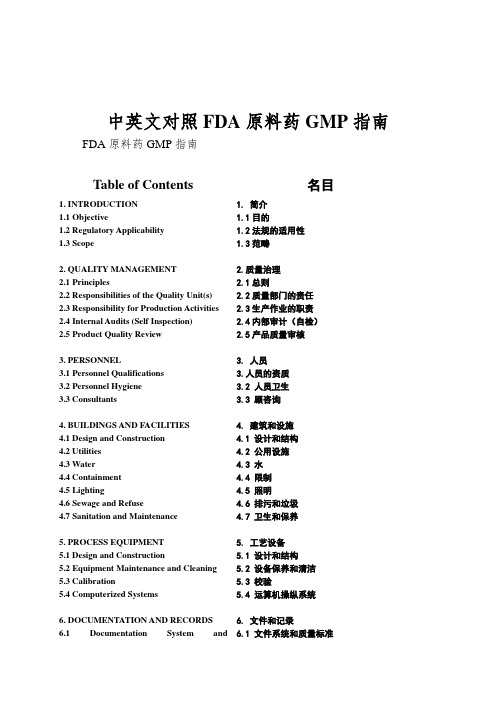
中英文对照FDA原料药GMP指南FDA原料药GMP指南Table of Contents 名目1. INTRODUCTION 1. 简介1.1 Objective 1.1目的1.2 Regulatory Applicability 1.2法规的适用性1.3 Scope 1.3范畴2. QUALITY MANAGEMENT 2.质量治理2.1 Principles 2.1总则2.2 Responsibilities of the Quality Unit(s) 2.2质量部门的责任2.3 Responsibility for Production Activities 2.3生产作业的职责2.4 Internal Audits (Self Inspection) 2.4内部审计(自检)2.5 Product Quality Review 2.5产品质量审核3. PERSONNEL 3. 人员3.1 Personnel Qualifications 3.人员的资质3.2 Personnel Hygiene 3.2 人员卫生3.3 Consultants 3.3 顾咨询4. BUILDINGS AND FACILITIES 4. 建筑和设施4.1 Design and Construction 4.1 设计和结构4.2 Utilities 4.2 公用设施4.3 Water 4.3 水4.4 Containment 4.4 限制4.5 Lighting 4.5 照明4.6 Sewage and Refuse 4.6 排污和垃圾4.7 Sanitation and Maintenance 4.7 卫生和保养5. PROCESS EQUIPMENT 5. 工艺设备5.1 Design and Construction 5.1 设计和结构5.2 Equipment Maintenance and Cleaning 5.2 设备保养和清洁5.3 Calibration 5.3 校验5.4 Computerized Systems 5.4 运算机操纵系统6. DOCUMENTATION AND RECORDS 6. 文件和记录6.1 Documentation System and 6.1 文件系统和质量标准Specifications6.2 Equipment cleaning and Use Record 6.2 设备的清洁和使用记录6.3 Records of Raw Materials, Intermediates, API Labeling and Packaging Materials 6.3 原料、中间体、原料药的标签和包装材料的记录6.4 Master Production Instructions (MasterProduction and Control Records)6.4 生产工艺规程(主生产和操纵记录)6.5 Batch Production Records (BatchProduction and Control Records)6.5 批生产记录(批生产和操纵记录)6.6 Laboratory Control Records 6.6 实验室操纵记录6.7 Batch Production Record Review 6.7批生产记录审核7. MATERIALS MANAGEMENT 7. 物料治理7.1 General Controls 7.1 操纵通则7.2 Receipt and Quarantine 7.2接收和待验7.3 Sampling and Testing of IncomingProduction Materials7.3 进厂物料的取样与测试7.4 Storage 7.4储存7.5 Re-evaluation 7.5复验8. PRODUCTION AND IN-PROCESSCONTROLS8. 生产和过程操纵8.1 Production Operations 8.1 生产操作8.2 Time Limits 8.2 时限8.3 In-process Sampling and Controls 8.3 工序取样和操纵8.4 Blending Batches of Intermediates orAPIs8.4 中间体或原料药的混批8.5 Contamination Control 8.5 污染操纵9. PACKAGING AND IDENTIFICATIONLABELING OF APIs ANDINTERMEDIATES9. 原料药和中间体的包装和贴签9.1 General 9.1 总则9.2 Packaging Materials 9.2 包装材料9.3 Label Issuance and Control 9.3 标签发放与操纵9.4 Packaging and Labeling Operations 9.4 包装和贴签操作10. STORAGE AND DISTRIBUTION 10.储存和分发10.1 Warehousing Procedures 10.1 入库程序10.2 Distribution Procedures 10.2 分发程序11. LABORATORY CONTROLS 11.实验室操纵11.1 General Controls 11.1 操纵通则11.2 Testing of Intermediates and APIs 11.2 中间体和原料药的测试11.3 Validation of Analytical Procedures 11.3 分析方法的验证11.4 Certificates of Analysis 11.4 分析报告单11.5 Stability Monitoring of APIs 11.5 原料药的稳固性监测11.6 Expiry and Retest Dating 11.6 有效期和复验期11.7 Reserve/Retention Samples 11.7 留样12. V ALIDATION 12.验证12.1 Validation Policy 12.1 验证方针12.2 Validation Documentation 12.2 验证文件12.3 Qualification 12.3 确认12.4 Approaches to Process Validation 12.4 工艺验证的方法12.5 Process Validation Program 12.5 工艺验证的程序12.6 Periodic Review of Validated Systems 12.6验证系统的定期审核12.7 Cleaning Validation 12.7 清洗验证12.8 Validation of Analytical Methods 12.8 分析方法的验证13. CHANGE CONTROL 13.变更的操纵14. REJECTION AND RE-USE OFMATERIALS14.拒收和物料的再利用14.1 Rejection 14.1 拒收14.2 Reprocessing 14.2 返工14.3 Reworking 14.3 重新加工14.4 Recovery of Materials and Solvents 14.4 物料与溶剂的回收14.5 Returns 14.5 退货15. COMPLAINTS AND RECALLS 15.投诉与召回16. CONTRACT MANUFACTURERS(INCLUDING LABORATORIES)16.协议生产商(包括实验室)17. AGENTS, BROKERS, TRADERS, DISTRIBUTORS, REPACKERS, AND RELABELLERS 17.代理商、经纪人、贸易商、经销商、重新包装者和重新贴签者17.1 Applicability 17.1适用性17.2 Traceability of Distributed APIs andIntermediates17.2已分发的原料药和中间体的可追溯性17.3 Quality Management 17.3质量治理17.4 Repackaging, Relabeling, and Holding of APIs and Intermediates 17.4原料药和中间体的重新包装、重新贴签和待检17.5 Stability 17.5稳固性17.6 Transfer of Information 17.6 信息的传达17.7 Handling of Complaints and Recalls 17.7 投诉和召回的处理17.8 Handling of Returns 17.8 退货的处理18. Specific Guidance for APIs Manufactured by Cell Culture/Fermentation 18. 用细胞繁育/发酵生产的原料药的专门指南18.1 General 18.1 总则18.2 Cell Bank Maintenance and RecordKeeping18.2细胞库的爱护和记录的储存18.3 Cell Culture/Fermentation 18.3细胞繁育/发酵18.4 Harvesting, Isolation and Purification 18.4收取、分离和精制18.5 Viral Removal/Inactivation steps 18.5 病毒的去除/灭活步骤19.APIs for Use in Clinical Trials 19.用于临床研究的原料药19.1 General 19.1 总则19.2 Quality 19.2 质量19.3 Equipment and Facilities 19.3 设备和设施19.4 Control of Raw Materials 19.4 原料的操纵19.5 Production 19.5 生产19.6 Validation 19.6 验证19.7 Changes 19.7 变更19.8 Laboratory Controls 19.8 实验室操纵19.9 Documentation 19.9 文件20. Glossary 20. 术语Q7a GMP Guidance for APIsQ7a原料药的GMP指南1. INTRODUCTION 1. 简介1.1 Objective 1.1目的This document is intended to provide guidance regarding good manufacturing practice (GMP) for the manufacturing of active pharmaceutical ingredients (APIs) under an appropriate system for managing quality. It is also intended to help ensure that APIs meet the quality and purity characteristics that they purport, or are represented, to possess. 本文件旨在为在合适的质量治理体系下制造活性药用成分(以下称原料药)提供有关优良药品生产治理规范(GMP)提供指南。
无菌药品和无菌工艺行业指南翻译
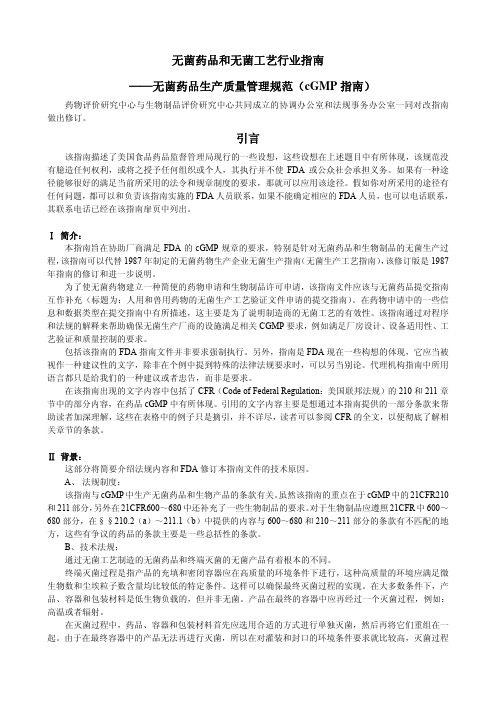
无菌药品和无菌工艺行业指南——无菌药品生产质量管理规范(cGMP指南)药物评价研究中心与生物制品评价研究中心共同成立的协调办公室和法规事务办公室一同对改指南做出修订。
引言该指南描述了美国食品药品监督管理局现行的一些设想,这些设想在上述题目中有所体现,该规范没有臆造任何权利,或将之授予任何组织或个人,其执行并不使FDA或公众社会承担义务。
如果有一种途径能够很好的满足当前所采用的法令和规章制度的要求,那就可以应用该途径。
假如你对所采用的途径有任何问题,都可以和负责该指南实施的FDA人员联系,如果不能确定相应的FDA人员,也可以电话联系,其联系电话已经在该指南扉页中列出。
Ⅰ简介:本指南旨在协助厂商满足FDA的cGMP规章的要求,特别是针对无菌药品和生物制品的无菌生产过程,该指南可以代替1987年制定的无菌药物生产企业无菌生产指南(无菌生产工艺指南),该修订版是1987年指南的修订和进一步说明。
为了使无菌药物建立一种简便的药物申请和生物制品许可申请,该指南文件应该与无菌药品提交指南互作补充(标题为:人用和兽用药物的无菌生产工艺验证文件申请的提交指南)。
在药物申请中的一些信息和数据类型在提交指南中有所描述,这主要是为了说明制造商的无菌工艺的有效性。
该指南通过对程序和法规的解释来帮助确保无菌生产厂商的设施满足相关CGMP要求,例如满足厂房设计、设备适用性、工艺验证和质量控制的要求。
包括该指南的FDA指南文件并非要求强制执行。
另外,指南是FDA现在一些构想的体现,它应当被视作一种建议性的文字,除非在个例中提到特殊的法律法规要求时,可以另当别论。
代理机构指南中所用语言都只是给我们的一种建议或者忠告,而非是要求。
在该指南出现的文字内容中包括了CFR(Code of Federal Regulation:美国联邦法规)的210和211章节中的部分内容,在药品cGMP中有所体现。
引用的文字内容主要是想通过本指南提供的一部分条款来帮助读者加深理解,这些在表格中的例子只是摘引,并不详尽,读者可以参阅CFR的全文,以便彻底了解相关章节的条款。
FDA-GMP中英文对照标准版

DIRECTION OF GMP (GOOD MANUFACTURING PRACTICE )OF RAW MATERIALS BY FDATable of Contents 目录1. INTRODUCTION1.1 Objective 目的1.2 Regulatory Applicability法规的适用性1.3 Scope 范围2. QUALITY MANAGEMENT .质量管理2.1 Principles 总则2.2 Responsibilities of the Quality Unit(s) 质量部门的责任2.3 Responsibility for Production Activities 生产作业的职责2.4 Internal Audits (Self Inspection) 内部审计(自检)2.5 Product Quality Review 产品质量审核3. PERSONNEL 人员3.1 Personnel Qualifications 人员的资质3.2 Personnel Hygiene 人员卫生3.3 Consultants 顾问4. BUILDINGS AND FACILITIES 建筑和设施4.1 Design and Construction 设计和结构4.2 Utilities 公用设施4.3 Water 水4.4 Containment 限制4.5 Lighting 照明4.6 Sewage and Refuse 排污和垃圾4.7 Sanitation and Maintenance 卫生和保养5. PROCESS EQUIPMENT 工艺设备5.1 Design and Construction 设计和结构5.2 Equipment Maintenance and Cleaning 设备保养和清洁5.3 Calibration. 校验5.4 Computerized Systems 计算机控制系统6. DOCUMENTATION AND RECORDS 文件和记录6.1 Documentation System and Specifications 文件系统和质量标准6.2 Equipment cleaning and Use Record 设备的清洁和使用记录6.3 Records of Raw Materials, Intermediates, API Labeling and Packaging Materials原料、中间体、原料药的标签和包装材料的记录6.4 Master Production Instructions (Master Production and Control Records)生产工艺规程(主生产和控制记录)6.5 Batch Production Records (Batch Production and Control Records)批生产记录(批生产和控制记录)6.6 Laboratory Control Records 实验室控制记录6.7 Batch Production Record Review 批生产记录审核7. MATERIALS MANAGEMENT 物料管理7.1 General Controls 控制通则7.2 Receipt and Quarantine 接收和待验7.3 Sampling and Testing of Incoming Production Materials 进厂物料的取样与测试7.4 Storage 储存7.5 Re-evaluation 复验8. PRODUCTION AND IN-PROCESS CONTROLS 生产和过程控制8.1 Production Operations 生产操作8.2 Time Limits 时限8.3 In-process Sampling and Controls 工序取样和控制8.4 Blending Batches of Intermediates or APIs 中间体或原料药的混批8.5 Contamination Control 污染控制9. PACKAGING AND IDENTIFICATION LABELING OF APIs AND INTERMEDIATES原料药和中间体的包装和贴签9.1 General 总则9.2 Packaging Materials 包装材料9.3 Label Issuance and Control 标签发放与控制9.4 Packaging and Labeling Operations 包装和贴签操作10. STORAGE AND DISTRIBUTION.储存和分发10.1 Warehousing Procedures 入库程序10.2 Distribution Procedures 分发程序11. LABORATORY CONTROLS 实验室控制11.1 General Controls 控制通则11.2 Testing of Intermediates and APIs 中间体和原料药的测试11.3 Validation of Analytical Procedures 分析方法的验证11.4 Certificates of Analysis分析报告单11.5 Stability Monitoring of APIs 原料药的稳定性监测11.6 Expiry and Retest Dating 有效期和复验期11.7 Reserve/Retention Samples 留样12. VALIDATION .验证12.1 Validation Policy 验证方针12.2 Validation Documentation 验证文件12.3 Qualification 确认12.4 Approaches to Process Validation 工艺验证的方法12.5 Process Validation Program 工艺验证的程序12.6 Periodic Review of Validated Systems 验证系统的定期审核12.7 Cleaning Validation 清洗验证12.8 Validation of Analytical Methods 分析方法的验证13. CHANGE CONTROL 变更的控制14. REJECTION AND RE-USE OF MATERIALS.拒收和物料的再利用14.1 Rejection 拒收14.2 Reprocessing 返工14.3 Reworking 重新加工14.4 Recovery of Materials and Solvents 物料与溶剂的回收14.5 Returns 退货15. COMPLAINTS AND RECALLS 投诉与召回16. CONTRACT MANUFACTURERS (INCLUDING LABORATORIES)协议生产商(包括实验室)17. AGENTS, BROKERS, TRADERS, DISTRIBUTORS, REPACKERS, AND RELABELLERS 代理商、经纪人、贸易商、经销商、重新包装者和重新贴签者17.1 Applicability 适用性17.2 Traceability of Distributed APIs and Intermediates已分发的原料药和中间体的可追溯性17.3 Quality Management 质量管理17.4 Repackaging, Relabeling, and Holding of APIs and Intermediates原料药和中间体的重新包装、重新贴签和待检17.5 Stability 稳定性17.6 Transfer of Information 信息的传达17.7 Handling of Complaints and Recalls 投诉和召回的处理17.8 Handling of Returns 退货的处理18. Specific Guidance for APIs Manufactured by Cell Culture/Fermentation用细胞繁殖/发酵生产的原料药的特殊指南18.1 General 总则18.2 Cell Bank Maintenance and Record Keeping 细胞库的维护和记录的保存18.3 Cell Culture/Fermentation 细胞繁殖/发酵18.4 Harvesting, Isolation and Purification 收取、分离和精制18.5 Viral Removal/Inactivation steps 病毒的去除/灭活步骤19. APIs for Use in Clinical Trials 用于临床研究的原料药19.1 General 总则19.2 Quality 质量19.3 Equipment and Facilities设备和设施19.4 Control of Raw Materials 原料的控制19.5 Production 生产19.6 Validation 验证19.7 Changes 变更19.8 Laboratory Controls 实验室控制19.9 Documentation 文件20. Glossary 术语1. INTRODUCTION 1. 简介1.1 Objective 1.1目的This document is intended to provide guidance regarding good manufacturing practice (GMP) for the manufacturing of active pharmaceutical ingredients (APIs) under an appropriate system for managing quality. It is also intended to help ensure that APIs meet the quality and purity characteristics that they purport, or are represented, to possess.本文件旨在为在合适的质量管理体系下制造活性药用成分(以下称原料药)提供有关优良药品生产管理规范(GMP)提供指南。
FDA无菌原料药检查指南
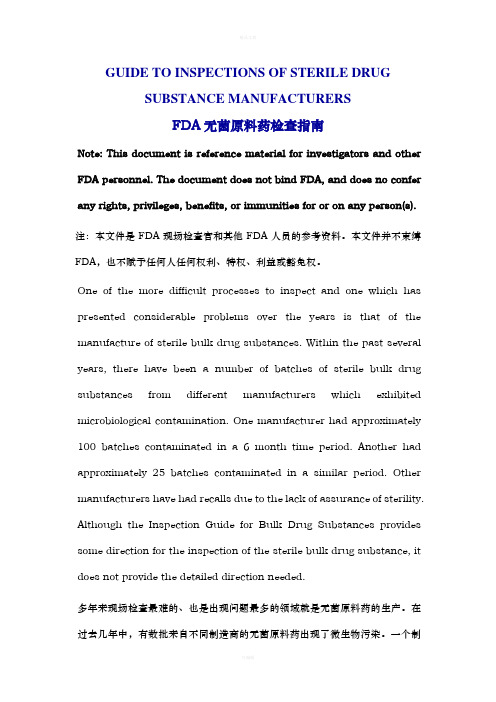
GUIDE TO INSPECTIONS OF STERILE DRUGSUBSTANCE MANUFACTURERSFDA无菌原料药检查指南Note: This document is reference material for investigators and other FDA personnel. The document does not bind FDA, and does no confer any rights, privileges, benefits, or immunities for or on any person(s). 注:本文件是FDA现场检查官和其他FDA人员的参考资料。
本文件并不束缚FDA,也不赋予任何人任何权利、特权、利益或豁免权。
One of the more difficult processes to inspect and one which has presented considerable problems over the years is that of the manufacture of sterile bulk drug substances. Within the past several years, there have been a number of batches of sterile bulk drug substances from different manufacturers which exhibited microbiological contamination. One manufacturer had approximately 100 batches contaminated in a 6 month time period. Another had approximately 25 batches contaminated in a similar period. Other manufacturers have had recalls due to the lack of assurance of sterility. Although the Inspection Guide for Bulk Drug Substances provides some direction for the inspection of the sterile bulk drug substance, it does not provide the detailed direction needed.多年来现场检查最难的、也是出现问题最多的领域就是无菌原料药的生产。
FDA无菌生产指南-中英文对照版.doc
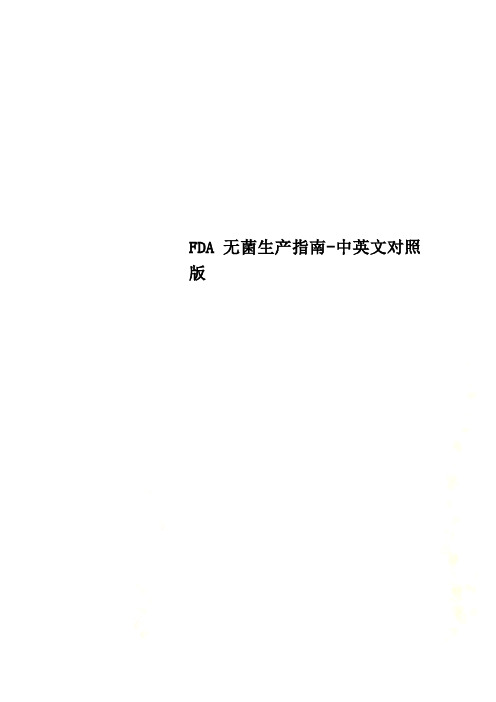
FDA无菌生产指南-中英文对照版Translated from / 译自:Guidance for IndustrySterile Drug Products Produced by Aseptic Processing —Current Good Manufacturing Practice行业指南无菌加工生产的无菌药品—现行的生产质量管理规范(cGMP)U.S. Department of Health and Human ServicesFood and Drug AdministrationCenter for Drug Evaluation and Research (CDER)Center for Biologics Evaluation and Research (CBER)Office of Regulatory Affairs (ORA)September 2004Pharmaceutical CGMPsCopyright SCI Version 1Copyright SCI Version 1Copyright SCI Version 1TABLE OF CONTENTSI. INTRODUCTION (1)简介II. BACKGROUND (2)背景A.Regulatory Framework (3)法规架构B.Technical Framework (3)技术架构III. SCOPE (5)适用范围IV. BUILDINGS AND FACILITIES (6)厂房和建筑A.Critical Area – Class 100 (ISO 5) (8)关键区域– 100级(ISO 5)B. Supporting Clean Areas (11)辅助洁净区域C. Clean Area Separation (11)净化区的隔离D.Air Filtration (13)空气过滤1.Membrane (13)膜过滤2.High-Efficiency Particulate Air (HEPA) (14)高效颗粒空气过滤器(HEPA)E.Design (17)设计V. PERSONNEL TRAINING, QUALIFICATION, & MONITORING (21)人员的培训,资格认定和监控A.Personnel (22)人员boratory Personnel (26)实验室人员C.Monitoring Program (26)监控程序VI. COMPONENTS AND CONTAINER/CLOSURES (28)药品成分和容器/密封A. Components (28)Copyright SCI Version 1药品成分B. Containers/Closures (31)容器/密封1.Preparation (31)准备2. .................................................................................. Inspection of Container Closure System33容器密封系统的检查VII. ENDOTOXIN CONTROL (35)内毒素控制VIII. TIME LIMITATIONS (37)时间限制IX. VALIDATION OF ASEPTIC PROCESSING AND STERILIZATION (38)无菌加工和灭菌的验证A. Process Simulations (38)工艺模拟1.Study Design (39)研究设计2.Frequency and Number of Runs (41)运行频率和次数3.Duration of Runs (42)运行时间4.Size of Runs (43)批量5.Line Speed (44)运行速度6.Environmental Conditions (44)环境质量7.Media (45)培养基8.Incubation and Examination of Media-Filled Units (46)培养基灌装单位的培养和检查9.Interpretation of Test Results (48)试验结果解释B. Filtration Efficacy (50)过滤功效C. Sterilization of Equipment, Containers, and Closures (53)设备、容器和密封的灭菌1.Qualification and Validation (54)确认和验证2.Equipment Controls and Instrument Calibration (56)设备控制和仪器校准X. LABORATORY CONTROLS (59)实验室控制Copyright SCI Version 1A. Environmental Monitoring (61)环境监测1. ...................................................................................................... General Written Program61书面程序2.Establishing Levels and a Trending Program (63)建立监测标准和趋势分析程序3.Disinfection Efficacy (64)消毒功效4.Monitoring Methods (64)监测方法B. Microbiological Media and Identification (66)微生物培养基及微生物的鉴定C. Prefiltration Bioburden (67)过滤前的生物负荷D. Alternate Microbiological Test Methods (68)可替代的微生物测试方法E. Particle Monitoring (68)颗粒监测XI. STERILITY TESTING (69)无菌试验A. Microbiological Laboratory Controls (71)微生物实验室控制B. Sampling and Incubation (71)取样和培养C. Investigation of Sterility Positives (72)无菌试验阳性结果的调查XII. BATCH RECORD REVIEW: PROCESS CONTROL DOCUMENTATION (77)批生产纪录审核:工艺控制文件化APPENDIX 1: ASEPTIC PROCESSING ISOLATORS (79)附录1: 无菌隔离装置APPENDIX 2: BLOW-FILL- SEAL TECHNOLOGY (87)附录2:吹-灌-封技术APPENDIX 3: PROCESSING PRIOR TO FILLING AND SEALING OPERATIONS (91)附录3:灌装和密封前的工艺REFERENCES (94)参考文献RELEVANT GUIDANCE DOCUMENTS (95)相关指南文件GLOSSARY (96)Copyright SCI Version 1术语表Copyright SCI Version 1Guidance for Industry1Sterile Drug Products Produced byAseptic Processing — Current Good Manufacturing PracticeI.INTRODUCTION简介This guidance is intended to help manufacturers meet the requirements in the Agency's current good manufacturing practice (CGMP) regulations (2l CFR parts 210 and 211) when manufacturing sterile drug and biological products using aseptic processing. This guidance replaces the 1987 Industry Guideline on Sterile Drug Products Produced by Aseptic Processing (Aseptic Processing Guideline). This revision updates and clarifies the 1987 guidance.本指南旨在帮助生产商在应用无菌工艺制造无菌药品和生物制剂时,达到FDA cGMP规章(美国联邦法规的第210及第211节)要求。
FDA工业指南用无菌工艺生产的无菌药品
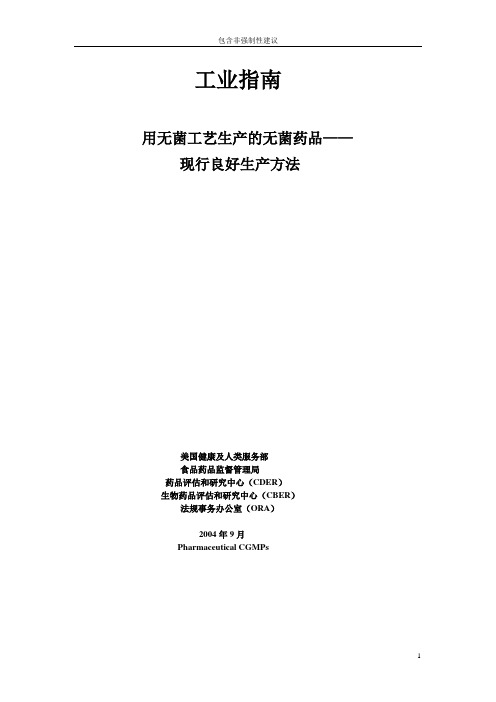
用无菌工艺生产的无菌药品——现行良好生产方法美国健康及人类服务部食品药品监督管理局药品评估和研究中心(CDER)生物药品评估和研究中心(CBER)法规事务办公室(ORA)2004年9月Pharmaceutical CGMPs用无菌工艺生产的无菌药品——现行良好生产方法美国健康及人类服务部食品药品监督管理局药品评估和研究中心(CDER)生物药品评估和研究中心(CBER)法规事务办公室(ORA)2004年9月Pharmaceutical CGMPs目录I、序言 (5)II、背景 (6)A、法规规章 (6)B、技术方面 (6)III、范围 (7)Ⅳ、厂房设施 (7)A、关键生产区-100级(ISO5) (8)B、辅助洁净区 (10)C、洁净区的分隔 (10)D、空气过滤 (10)1、膜 (10)2、高效空气过滤器(HEPA) (11)E、设计 (12)Ⅴ、人员培训、确认及监控 (14)A、人员 (15)B、实验室人员 (16)C、监控计划 (16)Ⅵ、组分和容器/密封件 (17)A、组分 (17)B、容器/密封件 (18)1、准备工作 (18)2、容器密封件系统的检查 (19)Ⅶ、内毒素的控制 (19)Ⅷ、时间限制 (20)Ⅸ、无菌生产加工方法及灭菌的验证 (20)A、模拟生产过程 (20)1、试验研究的设计 (21)2、运行的频次和次数 (22)3、运行的持续时间 (22)4、模拟运行的规模 (23)5、生产线的运行速度 (23)6、环境条件 (23)7、培养基 (23)8、灌装培养基单件的培养及检定 (24)9、检验结果的说明 (25)B、过滤效率 (26)C、设备、容器和密封件的灭菌 (27)1、确认和验证 (27)2、设备控制和仪器校验 (28)Ⅹ、实验室控制 (29)A、环境监控 (30)1、总的书面规划 (30)2、制定限量及趋势方案 (30)3、消毒灭菌效果 (31)4、监测方法 (31)B、微生物培养基及鉴别 (32)C、过滤前的微生物量 (32)D、可替代的微生物检验方法 (32)E、微粒监测 (33)Ⅺ、无菌检验 (33)A、微生物实验室控制 (34)B、取样及培养 (34)C、无菌试验阳性的调查研究 (35)Ⅻ、批生产记录审核:工艺控制文件 (36)附件1:无菌生产加工的隔离物 (38)附件2:吹—灌—封技术 (42)附件3:灌装及封口操作前的生产加工 (44)参考文献 (46)相关的指南文件 (48)术语汇编 (49)工业指南1用无菌生产加工方法生产的无菌药品——现行良好生产方法Ⅰ、序言本指南是要帮助用无菌生产加工方法生产无菌药品和生物制品生产单位,以符合FDA的CGMP 法规(21CFR210和211)。
美国FDA用无菌工艺生产灭菌药品的指南1 9 8 7年
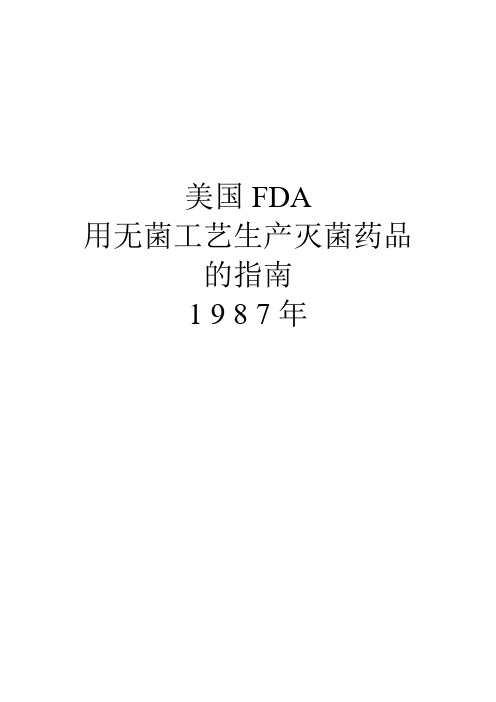
除这些生产区外,对有些设备也应提供高质量的过滤空气。设备中的空气与已灭菌的物料,或微生物和微粒含量均低的物料相接触处尤为重要。例如,除菌过滤器应用于冷冻干燥器真空间歇和热空气灭菌器的通风口处,以确保与已灭菌产品接触的空气是无菌的。同样,进入盛装已灭菌液体的常压容器中的空气也应是经过过滤的。用于盛装具有高度的微生物学的质量要求的物料贮罐内的空气也应是经过过滤的,并且过滤器应是干燥的,以防止随后堵塞凝聚,或微生物生长而弄湿(有两种方法可以达到这些要求,给过滤器供热和使用疏水性过滤器)。对这些空气过滤器定期进行完整性检测是重要的。
在灌装/封闭操作附近,空气不是需要具有高的微粒和微生物质量的唯—气体。接触产品、容器/密封件或产品接触的表面的其他气体,如N2和CO2(例如冲洗或复盖)也应经过无菌过滤。此外,压缩空气应无可检测到的油蒸汽。
关键区域相对于邻近的洁净要求较低的区域,应有正压差。可接受的压差为0.05inH2O。
控制区
控制区是准备未灭菌产品、加工过程中的物料和容器/密封件的区域,是第二类重要的环境控制区。它包括组件混合区和组件、加工过程中的物料、药品和经最后冲洗的与药品接触的设备、容器/密封件的表面暴露在工厂环境中的区域。为了降低最终产品中微粒污染物的水平和控制随后进行灭菌的物品及组件的微生物含量(生物负荷),这—环境应具有高的微生物和微粒质量要求。
在无菌工艺中,可以每—组分单独灭菌或几种组分合并成混合物后灭菌。组分灭菌有几种方法,如经过严格的验证,每一种方法均可被接受。一种广泛采用的方法是将组分溶解于—种溶剂(如美国药典注射用水)中形成溶液,过滤该溶液。过滤用无菌膜或筒形过滤器。在组分受热可能有不利影响的情况下可以用这种方法。该方法的另—种情况是使过滤后的溶液进行组分的无菌结晶和沉淀,成为无菌粉末。然而这种方法比其他方法涉及更多的处理和操作,因此在操作中污染的可能性更大。
FDA灭菌工艺验证申报资料指南(中英文)

Guidance for Industry for the Submission Documentation for Sterilization Process Validation in Applications for Human and Veterinary Drug Products人药和兽药无菌工艺验证申报资料的工业指南Center for Drug Evaluation and Research (CDER)Center for Veterinary Medicine (CVM)November 1994CMC 2FDA药品评价与研究中心(CDER)FDA兽药中心(CVM)1994年11月TABLE OF CONTENTSI. INTRODUCTION (1)A. Purpose (1)B. Documenting Sterilization Process Validation (2)C. Remarks (2)II. INFORMATION FOR TERMINAL MOIST HEAT STERILIZATIONPROCESSES (3)A. Description of the Process and Product ........................ .. (3)1. The Drug Product and Container-Closure System (3)2. The Sterilization Process (3)3. The Autoclave Process and Performance Specifications (4)4. Autoclave Loading Patterns (4)5. Methods and Controls to Monitor Production Cycles (4)6. Requalification of Production Autoclaves (4)7. Reprocessing (4)B. Thermal Qualification of the Cycle (4)1. Heat Distribution and Penetration Studies (4)2. Thermal Monitors (5)3. The Effects of Loading on Thermal Input (5)4. Information Included in the Batch Record ........................................... . 5C. Microbiological Efficacy of the Cycle (5)1. Identification and Characterization of Bioburden Organisms (6)2. Specifications for Bioburden (6)3. Identification, Resistance, and Stability of BiologicalIndicators (6)4. The Resistance of the Biological Indicator Relative to That ofBioburden (6)5. Microbiological Challenge Studies (7)D. Microbiological Monitoring of the Environment (7)E. Container-Closure and Package Integrity (7)1. Simulation of the Stresses From Processing (7)2. Demonstrate Integrity Following the Maximum Exposure (8)3. Multiple Barriers (8)4. The Sensitivity of the Test (8)5. Integrity Over the Product Shelf Life (8)F. Bacterial Endotoxins Test and Method (8)G. Sterility Testing Methods and Release Criteria (8)H. Evidence of Formal, Written Procedures (9)III. OTHER TERMINAL STERILIZATION PROCESSES (9)A. Ethylene Oxide (9)1. Description of the Sterilizer (9)2. Cycle Parameters (10)3. Microbiological Methods (10)4. Stability (10)B. Radiation (10)1. The Facility and the Process (10)2. The Packaging of the Product (10)3. Multiple-Dose Mapping Studies (10)4. Microbiological Methods and Controls (11)5. Monitoring Stability (11)IV. INFORMATION FOR ASEPTIC FILL MANUFACTURING PROCESSES WHICH SHOULD BE INCLUDED IN DRUG APPLICATIONS (11)A. Buildings and Facilities (11)1. Floor Plan (11)2. Location of equipment (11)B. Overall Manufacturing Operation (11)1. Drug Product Solution Filtration (12)2. Specifications Concerning Holding Periods (12)3. Critical Operations (12)C. Sterilization and Depyrogenation of Containers, Closures, Equipment, andComponents (12)1. Bulk Drug Solution Components That are SterilizedSeparately (13)2. Sterilization Information in the Batch Records (13)D. Procedures and Specifications for Media Fills (13)E. Actions Concerning Product When Media Fills Fail (14)F. Microbiological monitoring of the environment (15)1. Microbiological Methods (15)2. Yeasts, Molds, and Anaerobic Microorganisms (15)3. Exceeded Limits (15)G. Container-Closure and Package Integrity (15)H. Sterility Testing Methods and Release Criteria (16)I. Bacterial Endotoxins Test and Method (16)J. Evidence of Formal Written Procedures (16)V. MAINTENANCE OF MICROBIOLOGICAL CONTROL AND QUALITY: STABILITY CONSIDERATIONS (16)A. Container-Closure Integrity (16)B. Preservative Effectiveness (17)C. Pyrogen or Endotoxin Testing (17)VI. ADDITIONAL INFORMATION (17)GUIDANCE FOR INDUSTRY1FOR THE SUBMISSION OF DOCUMENTATION FOR STERILIZATION PROCESS VALIDATION IN APPLICATIONS FOR HUMAN AND VETERINARY DRUGPRODUCTS人药和兽药无菌工艺验证申报资料的工业指南I. INTRODUCTION1、概述A. PurposeThis document is intended to provide guidance for the submission of information and data in support of the efficacy of sterilization processes in drug applications for both human and veterinary drugs. The recommendations in the guidance apply to applications for sterile drug products (new drug applications, new animal drug applications, abbreviated new drug applications, abbreviated antibiotic applications, and abbreviated new animal drug applications). These recommendations also apply to previously approved applications when supplements associated with the sterile processing of approved drugs are submitted. Information and data in support of sterility assurance may also be necessary in investigational new drug and investigational new animal drug applications.A. 目的本文件旨在为证明人药和兽药无菌工艺有效性申请上报的信息和资料提供指南。
FDA外用制剂检查指南中英文版

GUIDE TO INSPECTIONS OF TOPICAL DRUG PRODUCTS局部外用药物检查指南Note: This document is reference material for investigators and other FDA personnel. The document does not bind(进退两难) FDA, and does no confer(赠予) any rights,privileges (特权), benefits(权益), or immunities(豁免) for or on any person(s).注:该指南是FDA 检查官和其他工作人员的参考材料。
该指南不是约束FDA,但也不赋予任何人特权,利益或豁免的权利。
I. PURPOSE(目的)The purpose of this guide is to provide field investigators, who arefamiliar with the provisions(食品) of the Current Good Manufacturing Practice (CGMP) regulations for pharmaceuticals, with guidance on inspecting selected facets(方面) of topical(局部的) drug product production. The subjects covered in the guide are generally applicable to all forms of topical drug products, including those that are intended to be sterile(无菌的). However, this guide does not address(介绍) every problem area that the investigator may encounter(碰见), nor every policy that pertains to(附属)topical drug products.该指南的目的是向熟悉食品CGMP规程的检察官提供药品CGMP的指导,提供局部外用药物检查方面的指南。
FDA无菌原料药检查指南-中英文版
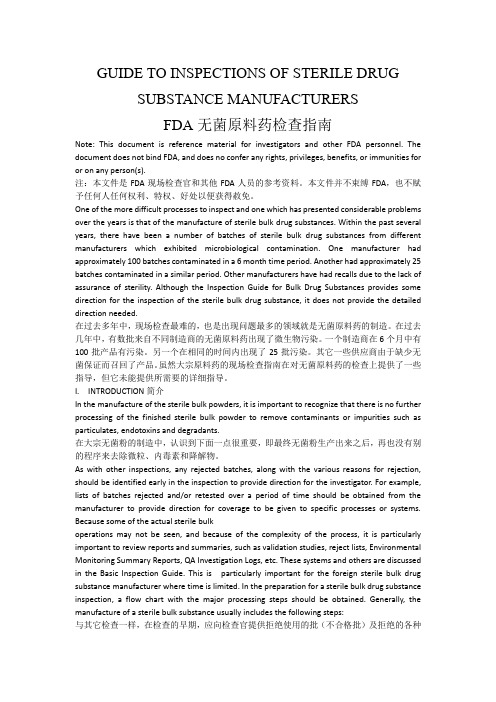
GUIDE TO INSPECTIONS OF STERILE DRUG SUBSTANCE MANUFACTURERSFDA无菌原料药检查指南Note: This document is reference material for investigators and other FDA personnel. The document does not bind FDA, and does no confer any rights, privileges, benefits, or immunities for or on any person(s).注:本文件是FDA现场检查官和其他FDA人员的参考资料。
本文件并不束缚FDA,也不赋予任何人任何权利、特权、好处以便获得赦免。
One of the more difficult processes to inspect and one which has presented considerable problems over the years is that of the manufacture of sterile bulk drug substances. Within the past several years, there have been a number of batches of sterile bulk drug substances from different manufacturers which exhibited microbiological contamination. One manufacturer had approximately 100 batches contaminated in a 6 month time period. Another had approximately 25 batches contaminated in a similar period. Other manufacturers have had recalls due to the lack of assurance of sterility. Although the Inspection Guide for Bulk Drug Substances provides some direction for the inspection of the sterile bulk drug substance, it does not provide the detailed direction needed.在过去多年中,现场检查最难的,也是出现问题最多的领域就是无菌原料药的制造。
- 1、下载文档前请自行甄别文档内容的完整性,平台不提供额外的编辑、内容补充、找答案等附加服务。
- 2、"仅部分预览"的文档,不可在线预览部分如存在完整性等问题,可反馈申请退款(可完整预览的文档不适用该条件!)。
- 3、如文档侵犯您的权益,请联系客服反馈,我们会尽快为您处理(人工客服工作时间:9:00-18:30)。
监控程序
VI. COMPONENTS AND CONTAINER/CLOSURES .................................................... 27
药品成分和容器 /密封 A. Components..................................................................................................................................27
法规架构 B. Technical Framework .......................................................................................................iologics Evaluation and Research Food and Drug Administration
1401 Rockville Pike, Rockville, MD 20852-1448 /cber/guidelines.htm.
辅助洁净区域 C. Clean Area Separation ................................................................................................................ 11
净化区的隔离 D. Air Filtration ................................................................................................................................ 12
Copyright SCI Version 1
Contains Nonbinding Recommendations
药品成分 B. Containers/Closures.....................................................................................................................30
设计
V. PERSONNEL TRAINING, QUALIFICATION, & MONITORING
........................ 20
人员的培训,资格认定和监控 A. Personnel.......................................................................................................................................21
容器 /密封 1. Preparation ....................................................................................................................................30
Additional copies are available from: Office of Training and Communication Division of Drug Information, HFD-240 Center for Drug Evaluation and Research
Translated from / 译自:
Guidance for Industry
Sterile Drug Products Produced by Aseptic Processing— Current Good Manufacturing Practice
行业指南 无菌加工生产的无菌药品 — 现行的生产质量管理规范 (cGMP)
U.S. Department of Health and Human Services Food and Drug Administration
Center for Drug Evaluation and Research (CDER) Center for Biologics Evaluation and Research (CBER)
空气过滤 1. Membrane ......................................................................................................................................13
膜过滤 2. High-Efficiency Particulate Air (HEPA) ....................................................................................... 14
高效颗粒空气过滤器 (HEPA) E. Design............................................................................................................................................16
内毒素控制
VIII. TIME LIMITATIONS ................................................................................................... 36
时间限制
IX. VALIDATION OF ASEPTIC PROCESSING AND STERILIZATION
准备 2. Inspection of Container Closure System ........................................................................................32
容器密封系统的检查 VII. ENDOTOXIN CONTROL ............................................................................................. 34
.................. 37
无菌加工和灭菌的验证 A. Process Simulations ....................................................................................................................3. 7
(Tel) Voice Information System at 800-835-4709 or 301-827-1800
U.S. Department of Health and Human Services Food and Drug Administration
Center for Drug Evaluation and Research (CDER) Center for Biologics Evaluation and Research (CBER)
Food and Drug Administration 5600 Fishers Lane
Rockville, MD 20857 (Tel) 301-827-4573
/cder/guidance/index.htm
or
Office of Communication, Training and Manufacturers Assistance, HFM-40
厂房和建筑 A. Critical Area –Class 100 (ISO 5) ................................................................................................. 8
关键区域 –100 级 (ISO 5) B. Supporting Clean Areas ..............................................................................................................11
III. SCOPE ............................................................................................................................... 4
适用范围
IV. BUILDINGS AND FACILITIES .................................................................................... 6
简介
II. BACKGROUND ............................................................................................................... 2
背景 A. Regulatory Framework ................................................................................................................. 2
